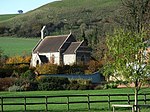Manningford Halt railway station
1932 establishments in EnglandBeeching closures in EnglandDisused railway stations in WiltshireFormer Great Western Railway stationsPages with no open date in Infobox station ... and 4 more
Railway stations in Great Britain closed in 1966Railway stations in Great Britain opened in 1932South West England railway station stubsUse British English from November 2017
Manningford Halt is a former railway station which opened in 1932 in Manningford parish, Wiltshire, England on the Berks and Hants Extension Railway between Pewsey and Devizes. The halt closed in 1966 when local services were withdrawn.The halt was about half a mile north of both Manningford Abbots and Manningford Bruce, west of the bridge carrying the Wilcot road over the railway, which had opened in 1862. The two platforms each had a small corrugated iron shelter.The station was demolished after closure leaving no trace of its existence. The track remains open as part of the Reading–Taunton line.
Excerpt from the Wikipedia article Manningford Halt railway station (License: CC BY-SA 3.0, Authors).Manningford Halt railway station
Geographical coordinates (GPS) Address Nearby Places Show on map
Geographical coordinates (GPS)
| Latitude | Longitude |
|---|---|
| N 51.3354 ° | E -1.802 ° |
Address
SN9 6JA , Manningford
England, United Kingdom
Open on Google Maps








